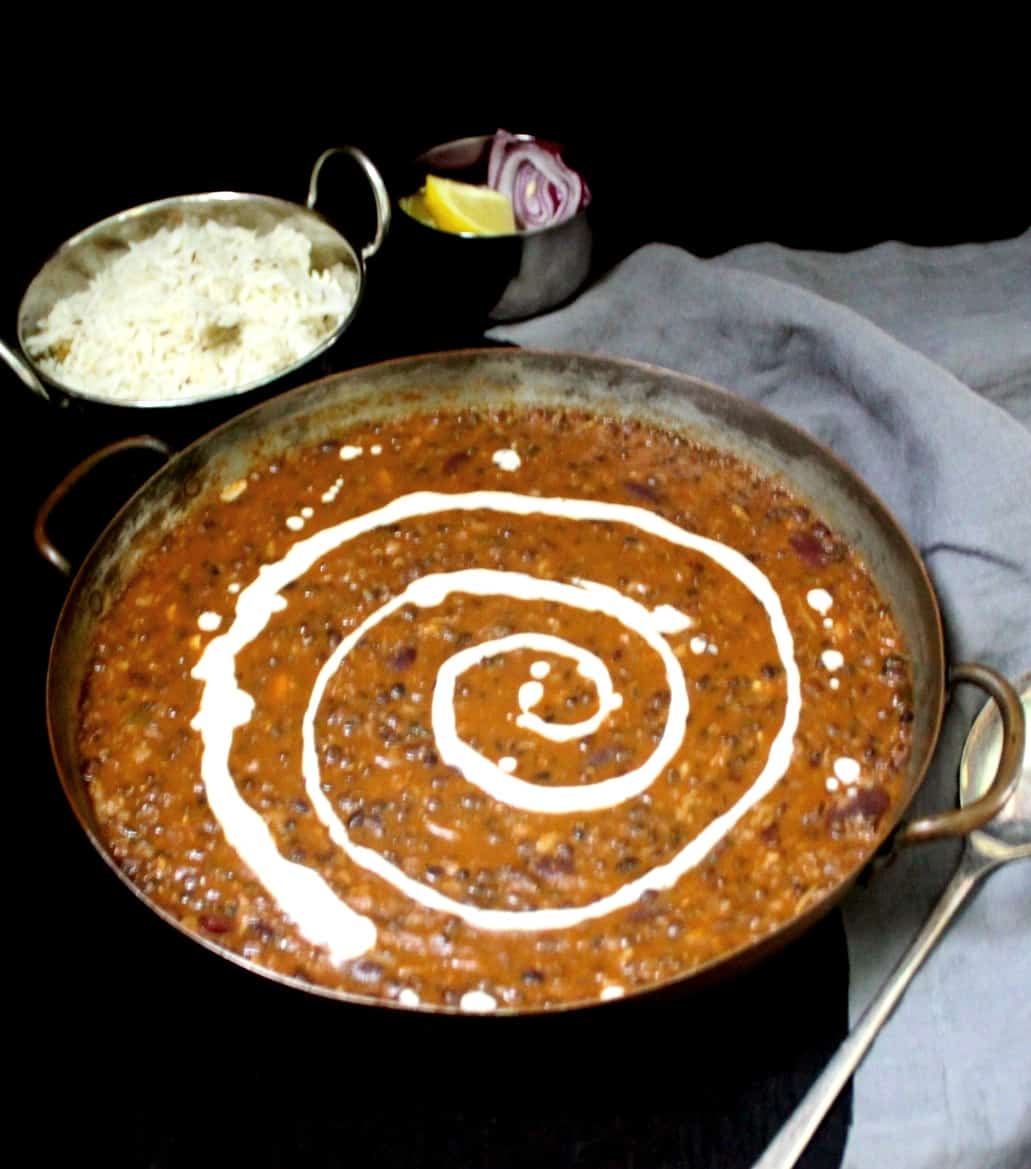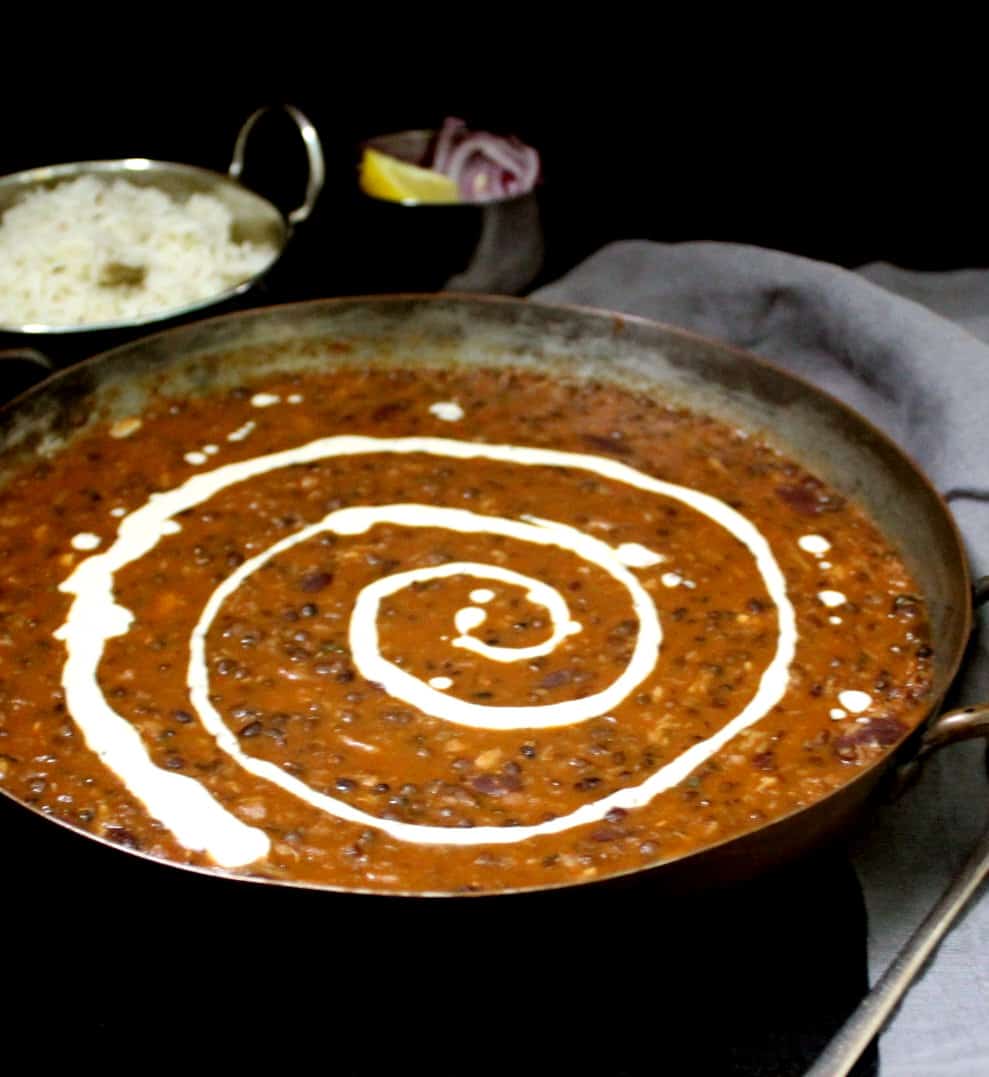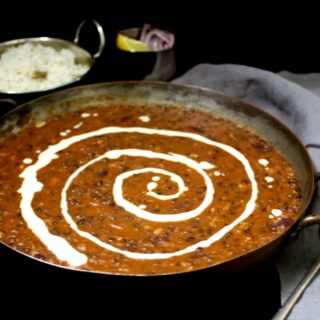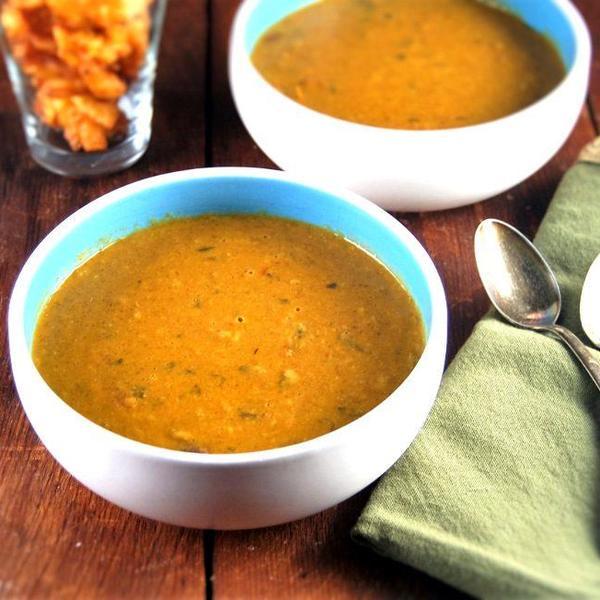
Dal Makhani is a North Indian restaurant style dish of creamy lentils flavored with butter and garnished with cream. My vegan dal makhani is dairy-free and it needs just 10 pantry ingredients, but it tastes traditional and authentic.

There are perhaps a million recipes for Dal Makhani on the internet – a testament to how beloved this Indian dish is. This is a smooth, creamy, buttery dal that you’ll frequently find on a restaurant menu, and the story goes that it was originally served in dhabas – tiny north Indian roadside eateries that sprung up to serve hungry truckers with food that was immensely tasty and often rich with butter and cream.
The butter (“makhan” in Punjabi) and cream are what make dal makhani so delicious. The spices are mild but the flavor is complex and bold with notes of spicy, sweet, tangy and bitter.
Veganizing dal makhani is not difficult, but you do need to make sure you are substituting with the right ingredients because the butter and cream play such a pivotal role in flavoring the dish. The tendency among many vegan cooks is to substitute the butter with something else that’s creamy, like coconut milk, but that just creates a dish with an overwhelmingly coconutty, not buttery, flavor. (Read more on how to veganize Indian dishes here).
For the most authentic-tasting vegan dal makhani, use vegan butter and cashew cream. Together, they add the same rich, smooth taste and, at just 131 calories a serving, they keep the dal makhani very healthy.
How to make vegan Dal Makhani
- In Indian kitchens, the lentil that goes into every dal recipe is chosen for a specific reason, and for a Dal Makhani, that special lentil is whole black urad dal or saboot urad, also known as black gram dal (read more about Indian lentils and beans in my guide to Indian pulses). This is a rounded lentil, ivory-white on the inside with a thin black skin on the outside, and it has a somewhat nutty flavor and a smooth, slightly slippery texture when cooked that gives this dal just the right finish. It is delicious in this spicy urad dal recipe. You can make this dal makhani with the split white urad dal, used in idlis and dosas, if you don’t have the whole lentil, but you won’t get quite the same texture.
- If you don’t have the urad lentils, use whatever you do have. Green or brown lentils, French puy lentils, or even Beluga lentils, which bear a skin-deep resemblance to saboot urad, are all okay.
- Many Punjabi cooks, but not all, add some rajma, or red kidney beans (also a legume or pulse that’s eaten widely in the Punjab) to their Dal Makhani. I like adding some rajma to my recipe as well, mainly because it gives a nice variation with its slightly al dente texture that contrasts nicely with the creamy richness of the dal. But if you don’t have red kidney beans, leave them out, that’s fine too.
- There’s no onion in this recipe, and it’s not needed, but if you want to add it, add finely chopped onions to the lentils while you’re cooking them.
- The only real time investment you need to make for this recipe is the cooking of the lentils and beans. While I am guilty of cooking my lentils in the pressure cooker when I am in a hurry, for your makhani to have a texture that’s as close as possible to the real thing, you should cook the lentils on the stovetop for at least an hour to an hour and a half or however long it takes for them to become creamy. This is not hands-on time, so you can definitely put the lentils on the stove and go do something else. Just remember to check on the lentils once in a while to be sure that they haven’t dried out. Add more water if they have. Keep in mind the kidney beans will take longer than the black lentils to cook, but that’s okay–you want the lentils to be creamy and mashable and the beans to be just tender.
- Other than the lentils, all you’ll need for this recipe are garlic, ginger, paprika (or degi mirch, a bright-red, mild to hot chili pepper powder used in Punjab and available at Indian grocery stores anywhere), tomato puree, kasoori methi (dry fenugreek leaves), vegan butter and cream. There’s no need to add garam masala or turmeric, even if you have them around.
- You can use canned tomato puree in this recipe, or you can use fresh, pureed tomatoes. Both work just as well.
- Add the cashew cream at the tail end of cooking. If you can’t eat nuts, or don’t want to use cashews, use pumpkin seeds and make a cream by blending the seeds with water.
Serve
Serve vegan dal makhani with a vegan naan or an easy Jeera Rice or both. You can also pair it with a soft, flaky roti.
If you’re making this a special meal, serve alongside a creamy, leafy curry, like Vegan Palak Paneer with Tofu or Sarson ka Saag. Add a Vegan Cucumber Raita on the side. Wash it all down with vegan Mango Lassi.
More vegan north Indian recipes
Love creamy Indian dals? You might also enjoy chaunsa dal, vegan Instant Pot dal makhani and spicy urad dal.


Vegan Dal Makhani
Vaishali · Holy Cow Vegan
Vegan dal makhani is a dairy-free version of the popular Indian restaurant dish, dal makhani. This easy recipe needs just 10 pantry ingredients and it tastes so delicious and authentic.
Prep Time 10 minutes
Cook Time 20 minutes
Dal cooking time 1 hour 30 minutes
Total Time 2 hours
Course Dal
Cuisine North Indian
Servings 10 servings
Calories 131 kcal
Instructions
-
Place the urad dal and rajma together in a large bowl and wash in three to four changes of water, rubbing the beans to remove all the dirt that may be sticking to them. Finally, top the beans with water by at least three inches. Let the beans soak at least eight hours or overnight.
-
Place the drained beans and lentils in a large stockpot along with 1 teaspoon of garlic and a bay leaf, if using. Cover by at least an inch and a half of water and bring them to a boil. If you see a white, frothy layer accumulate on top, skim it away. Cover and cook the lentils for an hour and a half or until the black lentils are really tender and the kidney beans are cooked but not falling apart.
-
Place 1 tablespoon of garlic and the ginger in a mortar and pestle and crush into a coarse paste. Set aside.
-
Blend the cashews with ¼ cup of water into a very smooth cream. Set aside.
-
Heat the oil in a saucepan. Add the ginger-garlic paste, saute until the garlic begins to turn blonde, then add in the paprika and the kasoori methi. Stir quickly and immediately add the tomato puree.
-
Cook the tomato puree for five minutes, stirring frequently. Stir in the sugar and add the cooked dal along with the liquid it was cooked in. If it looks like you have too much liquid, hold some back and add according to the consistency you want. If there’s too little liquid, add water to thin the dal out.
-
Bring the dal to a boil, cover, turn down the heat, and let it cook for five minutes. Use a potato masher or a heavy ladle to mash some of the lentils so the consistency gets creamier. Stir in the vegan butter and salt to taste. Add the cashew cream.
-
Check seasoning and add more salt if needed. Turn off the heat and serve hot or warm before serving.
Nutrition
Calories: 131kcalCarbohydrates: 18gProtein: 7gFat: 4gSaturated Fat: 1gPotassium: 276mgFiber: 6gSugar: 3gVitamin A: 625IUVitamin C: 7mgCalcium: 25mgIron: 3mg
Tried this recipe?Let us know in the comments below!
About Vaishali
Hi! I’m Vaishali, a journalist turned food blogger. At Holy Cow Vegan I share easy, tasty recipes made with clean, wholesome ingredients that the entire family can enjoy.

Leave a Reply